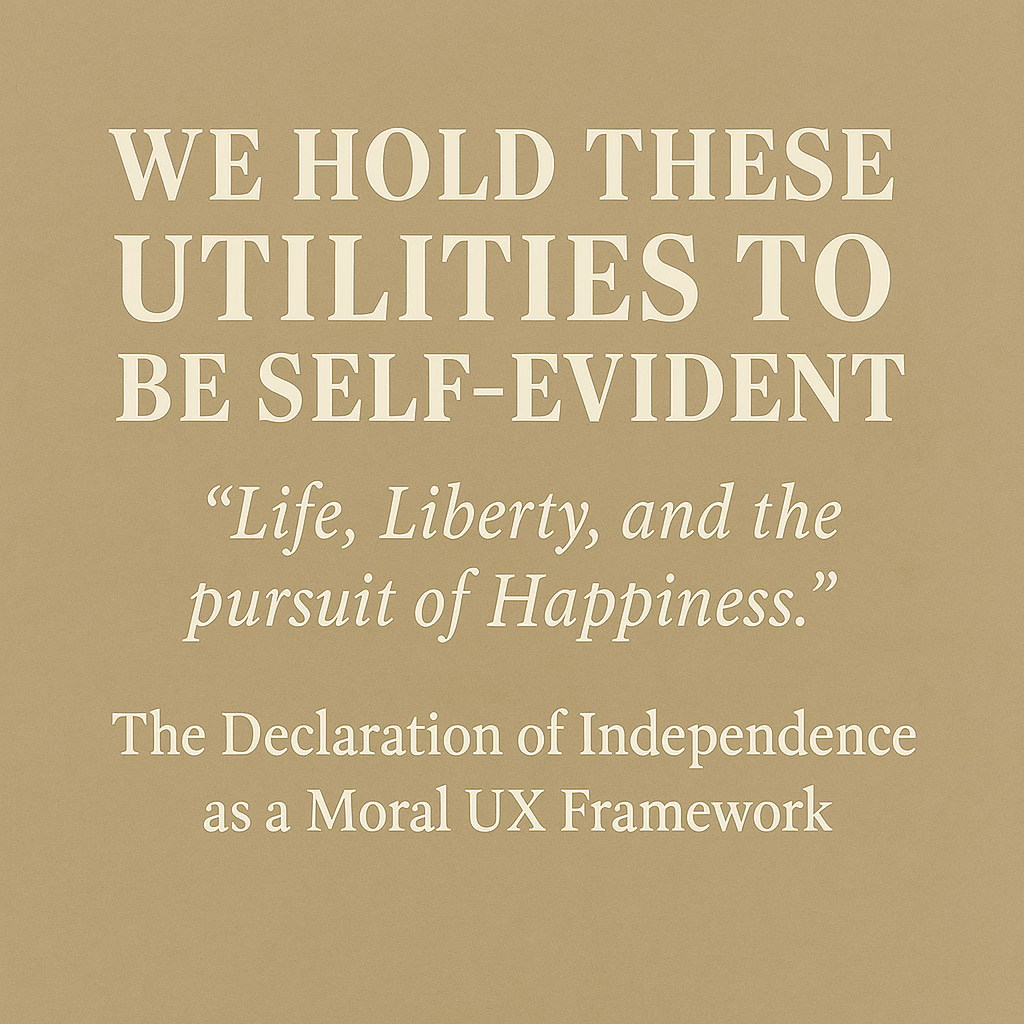From the THX Series Hub: Neurodivergence & the Founding of a Nation
The Declaration of Independence as a Moral UX Framework
“Life, Liberty, and the pursuit of Happiness.”
These weren’t just lofty ideals. They were early articulations of human experience expectations.
The Declaration of Independence wasn’t only a political rebellion—it was a formal list of systemic failures. A public moral UX complaint filed against a government that had lost legitimacy.
And if you read it closely, you’ll find something remarkable:
The very grievances listed in 1776 align almost perfectly with what we now call the 12 Utilities—the human standards we use to determine whether a system (or government) is just, trustworthy, and worth believing in.
A Declaration of Broken Utility
We’re taught to see the Declaration as political theater. But what if it was something more grounded—and more radical?
A human-centered audit of a failing system.
Consider the language:
“He has obstructed the administration of justice…”
“He has dissolved representative houses repeatedly…”
“He has refused his Assent to Laws, the most wholesome and necessary for the public good…”
These are not abstract complaints.
They’re precise indictments of broken systems.
Each grievance points directly to a Utility that was expected but not delivered.
The 12 Utilities in the Declaration’s Grievances
Let’s break down a few examples:
Access & Availability:
“He has refused to pass laws for the accommodation of large districts of people…”
→ The government made itself unavailable to the people it claimed to serve.Clarity:
“He has called together legislative bodies at places unusual, uncomfortable…”
→ Confusion and complexity were used to suppress participation.Security:
“He has kept among us, in times of peace, Standing Armies…”
→ Safety and protection were replaced by threat and occupation.Closure:
“For depriving us in many cases, of the benefits of Trial by Jury…”
→ The system refused to resolve grievances or offer resolution.Consistency:
“He has made Judges dependent on his Will alone…”
→ Justice was applied arbitrarily, not consistently.
These are the same questions we ask today, consciously or not:
Do I have access?
Am I safe here?
Will I be treated fairly?
Will anyone resolve what’s been done to me?
When a system fails across these dimensions, trust erodes.
When it fails long enough and loudly enough—revolution becomes reasonable.
The Pursuit of PERMAH
The Declaration doesn’t stop at listing harms.
It aims higher. It offers a vision.
“Life, Liberty, and the pursuit of Happiness.”
This is the first national expression of what we now call PERMAH:
Positive Emotion
Engagement
Relationships
Meaning
Achievement
Health & Wellbeing
To pursue happiness was not a casual phrase—it was a claim on the right to flourish. To be more than ruled. To be seen, heard, valued, and free to become.
And yet…
From the very beginning, this vision was incomplete.
Enslaved people. Indigenous genocide. Women without rights.
The Declaration laid out a universal structure of human dignity—then applied it selectively.
That contradiction still haunts us.
The Declaration as an Incomplete Blueprint
What makes the Declaration powerful is not that it was perfect.
It’s that it attempted to name what we deserve.
It said: A legitimate government must deliver certain things—or it forfeits its legitimacy.
This is the very essence of transformational experience design.
It is the beginning of what we now formalize in frameworks like:
RKYC: Really Know Your Citizen, not just your voter.
The 12 Utilities: Deliver human needs as systems.
PERMAH: Aim for flourishing, not just control.
Admiration Equation: Earn loyalty through action, not fear.
The Declaration said: We are not getting what we were promised. And we will not continue to give you our loyalty if you don’t deliver.
That’s not radical. That’s recognition.
What Would You Declare Today?
If the Declaration were a customer experience audit, what would yours say?
Who is withholding clarity from you?
Where are you being denied closure?
Which systems fail to deliver access, fairness, or meaning?
Who keeps power while you stay in limbo?
We don’t need to overthrow a king to write a new declaration.
We need to recognize that when the experience of being governed becomes dehumanizing, the only moral move is to design something better.
So I’ll ask you this:
If you were to write a new Declaration—not of Independence, but of Interdependence—what would it say?

Interpretation:
The parchment tone evokes the historical reverence we’re taught to hold for the Declaration—while the bold typography reclaims it as a living document, a framework, and a moral claim. This isn’t just history. It’s a mirror. What we accept—or challenge—today says everything about whether we still hold these truths to be self-evident.



